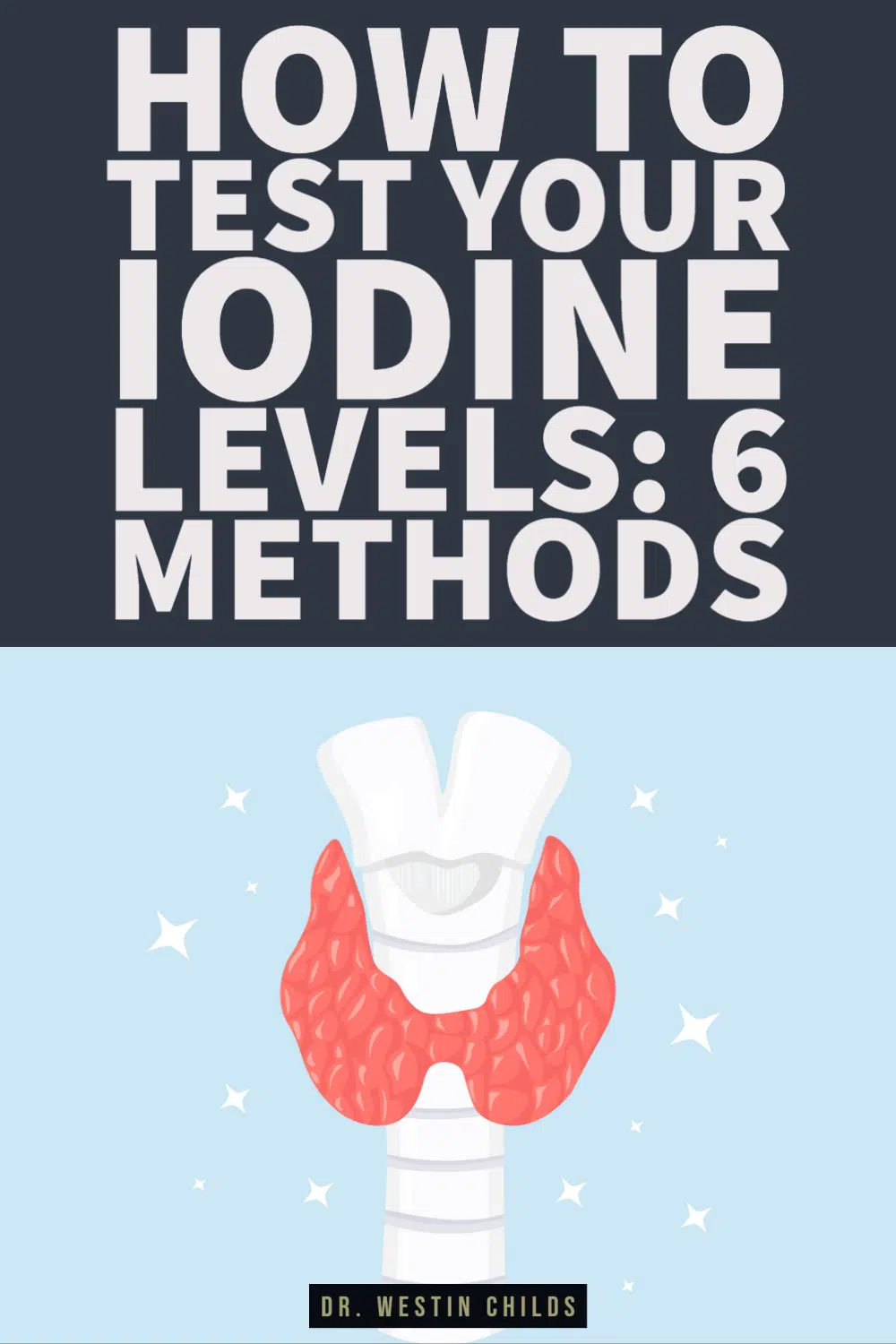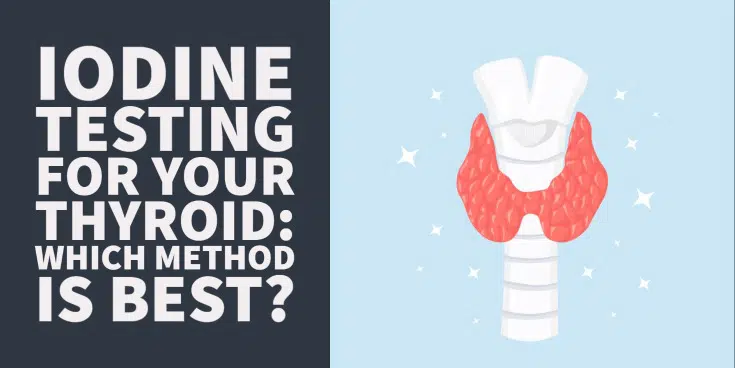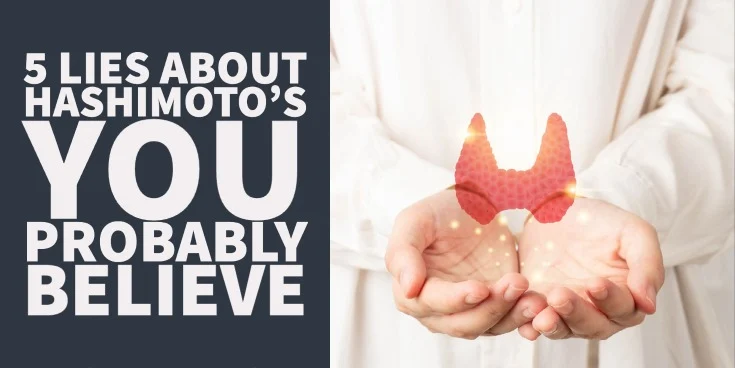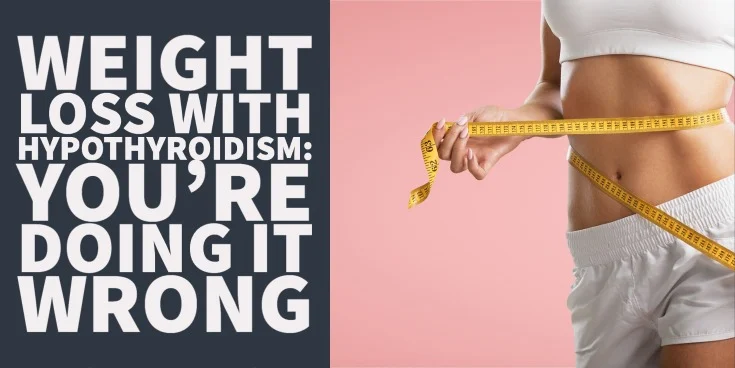For some reason, few topics are more controversial than iodine when it comes to thyroid management.
Today, we are wading into the waters of controversy by talking about iodine testing.
And it makes sense why testing for iodine is something on a lot of people’s minds.
Iodine is one of the most important nutrients as far as the thyroid is concerned because it’s required for the creation of thyroid hormone.
It makes sense, then, that you’d want to test how much iodine you have to see if you have enough to fulfill this requirement.
Unfortunately, it’s not quite that simple.
There are no fewer than 6 different ways that you can test for iodine in your body and each one has pros and cons and none are 100% accurate.
For this reason, we need to take a deep dive into iodine testing to help you figure out which test would be best for your situation.
To complicate things further, it’s not always necessary or even a good idea to test your iodine levels.
This concept will become obvious as we dive into the flaws of each iodine testing.
At the end of this article, I will give you some practical advice including who should get tested and which iodine test is probably the best all around.
Before we talk about iodine testing, though, we need to lay down some basic facts about iodine itself.
These facts are important because they will lay the basic framework that we will then build upon when we talk about how to check iodine levels.
In addition, these are basic things that EVERY patient should know and understand and they are fairly simple and straightforward.
Facts about iodine that you should know:
- All humans need it – If you are a human and you are reading this then you need iodine (1). Humans require iodine because it is required to produce thyroid hormone. And thyroid hormone is required to sustain life. Because humans can’t produce it on their own, they MUST get it from their diet. From a practical standpoint, this means you must get iodine from the food that you eat or from supplements that you take. There are some less common ways that iodine can enter your system and we will talk about those later.
- Iodine is stored predominately in the thyroid gland – The vast majority of iodine that your body stores is held up inside of your thyroid gland (2). This is important because it impacts how easily we can check iodine levels inside of the body. Unfortunately, we don’t have a good way to check the iodine status of individual cells inside of the thyroid gland so we have to use other metrics which act as a proxy for iodine testing. This is one big reason why iodine testing is so inaccurate. Even if it was possible to stick a needle into your thyroid gland to check your iodine status it wouldn’t be practical. No one would want to get that potentially dangerous procedure done as frequently as would be necessary.
- Other tissues also need iodine outside of the thyroid gland – Even though the majority of iodine in your body is stored inside of your thyroid gland, other tissues still have a need for iodine as well. This is important because doctors often tell patients who do not have a thyroid (or those who have had their iodine ablated with RAI) that they don’t need iodine and this isn’t true. Iodine is still used by breast tissue, nerve cells, your eyes, stomach cells, and salivary glands (3).
- Iodine has the potential to be harmful if taken in excessive doses – This is really where the controversy with iodine comes in. There are groups of people who believe ALL iodine should be avoided, there are groups who believe that everyone should take massive doses of iodine, and there are people who believe something in the middle. While there is truth in each group what I want to point out here is that it is definitely the case that high doses of iodine have the potential to be harmful. High doses don’t universally cause problems for anyone who uses them but they do have that potential. For that reason, it’s a good idea to avoid high doses of iodine unless you are being monitored. This will come into play when we talk about a specific type of iodine testing known as the iodine loading test later.
- Standard iodine testing is usually not very accurate – For the reasons I have mentioned, iodine testing is not very accurate and this will become even more obvious as we continue.
- Individual iodine intake varies dramatically so standard advice is difficult to make – Lastly, you should be aware that iodine intake between groups of people, individuals, countries, cities, etc. varies quite dramatically. Because of this, it’s hard to make any universal or standard advice that applies to every single person or every single thyroid patient. It might be tempting to try and sort this out by using an iodine test but it’s not quite that easy as you will soon find out.
DOWNLOAD FREE RESOURCES
Foods to Avoid if you Have Thyroid Problems:
I’ve found that these 10 foods cause the most problems for thyroid patients. Learn which foods you should avoid if you have thyroid disease of any type.
The Complete List of Thyroid Lab tests:
The list includes optimal ranges, normal ranges, and the complete list of tests you need to diagnose and manage thyroid disease correctly!
#1. Urinary Iodine Level
The first and probably easiest way to check your iodine status is by looking in your urine.
It turns out that your body attempts to eliminate extra iodine in circulation by peeing it out.
This means that you can check the urine for iodine content and infer, based on that information, how much iodine is in the body.
The idea is that if extra iodine is present then it would be peed out by the body.
Conversely, if you were deficient in iodine then there wouldn’t be any extra in your urine because your body would be trying to save and hold on to as much iodine as possible.
One of the big problems with urinary iodine is that it really only gives you a snapshot of your iodine intake during any single day.
Imagine you consumed a meal that was extremely high in iodine the day before and then had your urinary iodine levels checked the next morning.
Your test would show that your body was eliminating extra iodine which might cause you to believe that you have more iodine in your body than necessary.
But if you zoom out of that single day and realize that this was the only major source of iodine that you consumed over the last 60 days, that information becomes far less important and relevant.
Because of this flaw, if you want to get an idea as to your daily iodine intake then you need to have your urinary iodine levels checked on the order of hundreds of times.
Over hundreds and hundreds of tests, you can get a pretty good idea of your iodine intake but this simply isn’t practical.
Spot urinary iodine testing is often used by researchers to assess the average iodine consumption of a large population, but it’s not a great test for assessing iodine intake of any individual (unless you use it hundreds of times on the same person).
Within the category of urinary iodine testing, there are 3 different types of iodine tests available and each one gives you slightly different information:
- The first is the spot urinary iodine level (4) – The spot urinary level uses a random sample of urine during the day to check your iodine level. As mentioned above, this one is better for assessing the iodine intake of a population.
- The second is the urinary iodine to creatinine ratio (5) – You can take urinary iodine testing a step further by assessing urinary iodine levels in relation to your kidney function. This gives you a slightly better and more accurate assessment of your iodine by putting it into context with your kidney function. If you are going to get any of the urinary iodine tests then this one is probably the best.
- And the third is the 24-hour urinary iodine level (6) – The next option is to get the 24-hour urinary iodine test. With this test, you are required to collect 24 hours’ worth of urine and put it in one big container. If done correctly, this is a better measure of iodine intake throughout the day but it’s also not very practical and is fraught with user errors and complications. For these reasons, it’s not an ideal test for most people.
Even though the urinary iodine levels are not very accurate they are still one of the better tests available because they are readily available and don’t require much from you as the patient.
If it comes down to it, and you aren’t sure what type of iodine test to get, then I’d recommend starting with a spot urinary iodine to creatinine ratio test for both simplicity and accuracy.
#2. Serum Iodine
Not only can you check iodine in your urine, you also have the option to check iodine status in your bloodstream.
And you can do this by checking what is called serum iodine.
Serum is a component of your blood that gets created after the coagulation of red blood cells.
Serum iodine is frequently ordered by doctors because it can be drawn and tested at the same time as when you get your thyroid lab tests drawn.
The idea would be to put your blood iodine level into context with your thyroid lab tests for a better picture of your overall thyroid health.
But if you’ve spent any time around my blog then you know it’s not frequently recommended on my list of required thyroid lab tests for several reasons.
The iodine in your blood is there because it’s being transported either to the thyroid gland to be used or to the kidneys to be eliminated (7).
When it comes to serum iodine testing, it tends to really only be accurate when you’ve taken very large doses of iodine.
In that setting, your serum iodine level will be elevated when you get tested.
It takes a lot of iodine to elevate your serum iodine levels, though, which means that low to normal blood levels of iodine do not always mean that you are normal or low on iodine.
For this reason, serum iodine is really only helpful in cases of iodine overdose or after an extremely high dose of iodine has been consumed.

Due to these problems, serum iodine isn’t an ideal test for everyday use or for most people.
There have been some studies (8) that show that serum iodine may correlate with urinary iodine levels, though, which is probably why it gets ordered and tested by some doctors.
Even if it is true that serum iodine correlates with urinary levels (to some degree), it still makes more sense to order a urinary level as opposed to the blood level due to ease of testing and accuracy.
#3. Serum Thyroglobulin
If you have Hashimoto’s then you’re probably aware of a similar-sounding test known as thyroglobulin antibody.
These two tests are NOT the same thing.
Thyroglobulin is a protein that is prevalent in the thyroid gland and you can check for thyroglobulin levels as a separate test from the thyroglobulin antibody test.
Thyroglobulin antibody test is a measurement of antibodies that target the thyroglobulin protein and even though they sound similar they are not the same, so don’t get confused!
The thyroglobulin test (9) is sometimes used as an indirect measure of iodine status, especially when testing large populations for iodine status.
Because it is a proxy marker it is not 100% accurate but we do know that low levels of iodine correlate with high thyroglobulin levels and high levels of iodine correlate with low thyroglobulin levels.
Sometimes researchers will use thyroglobulin levels to then assess the iodine status of populations using this relationship.
Aside from the fact that thyroglobulin is a proxy marker of iodine status it also suffers from one huge flaw:
It is not accurate for anyone who has autoimmune thyroiditis or Hashimoto’s thyroiditis!
And, if you’ve been paying attention, then you know that about 90% of all cases of hypothyroidism are caused by this autoimmune condition which renders it ineffective for MOST of you reading this article.
After all, those people who don’t have thyroid disease are far less interested in assessing their iodine level compared to those with thyroid disease (for whom it matters much more).
So even though thyroglobulin testing may have some application in testing the iodine status of large populations, it’s not helpful for anyone with existing thyroid disease so we can scratch this one off of the list.
#4. Iodine Patch Test
The iodine patch test is often recommended among natural practitioners as a way to generally assess iodine status in the body.
This test is done by applying a topical iodine solution to the skin and then monitoring how much of that iodine is absorbed over a period of time.
The idea is that if the iodine is absorbed rapidly then your body must have needed it, therefore, you were deficient.
If, on the other hand, the iodine isn’t absorbed or if it is absorbed slowly then you can infer that your body has sufficient iodine for its needs.
Unfortunately, this testing method is dubious and very inaccurate.
It may work if iodine stays on the skin and 100% of it is absorbed by the body but much of the iodine left on your open skin evaporates into the air and as it is exposed to the air it changes color.
Because of this, it’s really impossible to know how much iodine is getting absorbed and at what rate.
While the patch test is not ideal for accurately assessing iodine levels in your body it can be used to assess for iodine-induced allergy or contact dermatitis (10).
It’s unlikely that a true iodine allergy even exists (11), though, so this test should not have much application for most thyroid patients.
#5. Iodine Loading Test
Another iodine test commonly used by holistic or natural practitioners is the iodine loading test.
This test is sometimes referred to as the iodine challenge test, the iodine loading test, or the urine challenge test.
It works like this:
The patient is given a massive dose of iodine, usually around 50mg of iodine, and then their urine is collected for the next 24 hours.
The urine is then evaluated to determine your iodine status.
If your 24-hour collected urine has high concentrations of iodine then it is thought that your body did not need the iodine that you took and you are therefore iodine sufficient.
If, on the other hand, your urine has low levels of iodine then it is felt that your body must have needed that iodine and you would be considered iodine deficient and in need of more iodine.
In theory, this test seems to check all of the boxes.
It provides more accuracy than regular spot urinary iodine tests because you are controlling and standardizing iodine intake (as opposed to being at the mercy of whatever iodine you randomly consumed the day before) and then collecting the urine over a 24 hour period.
Unfortunately, it falls short for a few reasons:
#1. Your body may take more than 24 hours to eliminate or get rid of the iodine loading dose which casts doubt on the accuracy of the test.
#2. Kidney function is not being controlled for which means results may vary from person to person based on their kidney function.
And #3. Loading yourself with 50mg of iodine in order to check your iodine status is potentially problematic and dangerous.
If you go back to the introduction of this article you will see that one of the facts about iodine intake is that excessively high doses of iodine have the potential to cause problems for certain individuals.
And 50mg of iodine certainly qualifies as an excessively high dose of iodine.
With the recommended RDA of iodine intake somewhere around 150 to 270mcg (12), a dose of 50mg is the equivalent of taking 50,000mcg in one day or approximately 250 times more than the recommended daily intake by RDA values.
This type of dose definitely has the potential to cause problems for certain individuals and it doesn’t make sense to use a test that may cause harm to test for a nutrient that is inaccurate and may not even be necessary to test for.
For these reasons, it’s often best to avoid the iodine loading test.
#6. Iodine Hair Analysis
Lastly, it’s also possible to assess the iodine content of your hair.
From there you can try to make an inference on the iodine status of the entire body.
This method of testing seems like a good idea because it’s minimally invasive and readily testable.
Unfortunately, nutrient levels in your hair do not always correlate with nutrient levels in your body or tissues.
For instance, the iodine content of your hair does not correlate with the iodine content of your thyroid gland.
It was thought that there may be a correlation between the two but one of the major studies (13) showing this relationship has been retracted.
At this time it is not felt that iodine hair analysis is an accurate measure of iodine status in the body.
It may be the case that emerging hair analysis tests that involve more than just iodine (14) may provide more accurate information on iodine status in the body.
But for now, it’s best to avoid iodine hair analysis and go for one of the more accurate measurements listed above.
Do You Even Need Testing?
With all of this information in front of you, your next step is to determine if you even need to test your iodine.
And the answer is probably not.
Here’s why:
Before you get your iodine tested, you have to ask yourself what you are hoping to get out of the test.
In other words, what does the information you get from the test mean for you?
Most people who get their iodine tested do so because they are curious about their iodine intake or because they think it will impact their thyroid treatment or management in some way.
The problem with this line of thinking is that most thyroid patients can do 100 other things before they even think about testing their iodine status and all of these other things DO have an impact on how they are feeling.
These patients would be far better served by focusing on these areas FIRST:
- Thyroid function – There are other important nutrients involved in the production of thyroid hormone including iron and l-tyrosine. Iodine is important for thyroid production but it’s not the only nutrient.
- Thyroid conversion – The conversion of T4 to T3 may be the most important aspect of thyroid function that both doctors and patients ignore. Various natural treatments may be able to help you produce more T3 and feel better.
- Thyroid medication dose – I would hazard a guess that the majority of thyroid patients feel poorly because their thyroid medication is not optimized. This is definitely one of the first places to look if you are feeling poorly.
- Thyroid lab tests – Getting a complete thyroid lab panel provides you with information on all of the areas we are discussing here. If you haven’t undergone a complete thyroid lab panel then spend some time and energy to make that happen.
- Other nutrients – Other nutrients such as vitamin D, zinc, selenium, B vitamins, and magnesium are also important for thyroid function. Testing for most of these nutrients is easier to understand compared to iodine testing and replacing deficiencies is both cheap and easy.
- Inflammation – Inflammation can negatively impact thyroid function as well as other hormone systems in your body. When was the last time you had your inflammatory markers checked in your blood?
- Immune system – Your immune system plays an important role in those with Hashimoto’s (which is most people with thyroid disease). Certain therapies can be used to improve immune function and, therefore, thyroid function.
- Gut Health – Your gut is a big site of thyroid conversion and the place where your thyroid medication gets absorbed. By treating your gut you can often indirectly improve the effectiveness of your thyroid medication in two different ways.
- Liver health – The liver is the major site of T4 to T3 conversion and is often disrupted by conditions such as fatty liver from insulin resistance. Many thyroid patients are susceptible to this condition and improving liver health can improve thyroid function.
Given that these systems are far more important for evaluating thyroid function and that they are much more accurate than iodine testing, why would you start with iodine?
My recommendation for MOST people is to focus on these areas first
So before you test your iodine status ask yourself what is the reason for testing.
If it’s just for curiosity or because you heard it was important, you may want to think twice.
Doing it for this reason may provide more confusion and less clarity and ultimately make getting on the right treatment more difficult.
The next thing you should do before you get your iodine tested is to take stock of your iodine intake from ALL potential sources.
You may know some of the more common sources of iodine intake but there are still plenty of others that most thyroid patients aren’t even aware of or don’t account for.
These places include:
- High iodine intake from foods – There are obvious food sources of iodine and not-so-obvious sources. Obvious sources would include pretty much anything from the sea including seaweed, tuna, and other fish. Not so obvious sources may include things like milk, dairy, cheese, deli meat, and even eggs. Pay attention to what you are eating and the iodine content of that food!
- Beauty products – Believe it or not, beauty products may be a hidden source of iodine. Not all beauty products contain iodine and not all of that iodine is absorbed through the skin but it can have an impact on some people. Iodine can be hidden in beauty products as PVP-I which is short for polyvinylpyrrolidone-iodine. It’s worth doing a quick search of your beauty products to see if they are a hidden source of iodine for you. If they are swap them out for iodine-free versions.
- Prescription medications – Some prescription medications also may contain iodine that you are not accounting for.
- Supplements – Supplements, of course, may also be a source of iodine ingestion for you. This one is relatively easy to check by looking at the back of your supplements to see what is inside of them (hopefully, you’ve already done this!). Make sure to take stock of the total amount of iodine in each of your supplements.
- Iodized salt – Lastly, iodine can also be added to salt. Salt with iodine is known as iodized salt. This was done to reduce the incidence of goiter but it can be yet another source of iodine ingestion for thyroid patients.
And lastly, before you get your iodine tested, remember that the body requires it to function properly!
Humans require around 150 to 270mcg of iodine each and every day (women who are pregnant and lactating need higher amounts).
Because it is required and because humans must obtain it from their diet, I feel comfortable recommending that everyone (with some exceptions) consumes iodine in supplement form on a daily basis.
I’ve tested tens of thousands of thyroid patients (who use my thyroid supplements that contain iodine) over the last 5 years and I just don’t see problems using this dose of iodine.
Based on my own experience, most thyroid patients are perfectly fine using low-dose iodine in supplement form in the range of 150 to 270mcg per day UNLESS you have a prior history of negative reactions to iodine supplementation OR if you believe that you are getting excessive iodine intake from the other sources mentioned previously.
If you are someone who has reacted negatively to iodine in the past then you may want to consider going on a low iodine diet before you get your labs checked.
If you feel better on a low iodine diet then there is no need to get tested.
If the low-iodine diet isn’t working for you over a period of time then the testing may help you determine if you should continue with the low-iodine diet or if some other problem is contributing to your current symptoms.
Final Thoughts
When it comes to iodine testing, it is most often beneficial if used as a last resort.
The reason for this is that most thyroid patients can comfortably supplement with low-dose iodine without any issues and because there are plenty of other areas that thyroid patients can focus on which provide far more benefit to their thyroid and overall health.
If you do decide that testing your iodine is important and/or necessary then the best option is probably the urinary iodine to creatinine ratio.
This test provides you with an idea of your iodine excretion over a short period of time and provides that information relative to kidney function.
If you want to get an even more accurate picture of your iodine status then you can also combine other iodine lab tests as well which may help paint a clear picture of your iodine status.
Before you do, though, be aware of the limitations of each test and what kind of information they actually give you.
Now it’s your turn:
Are you thinking about getting your iodine levels tested?
Have you had your iodine status tested in the past?
Did the information you received from that lab test help you to feel better?
If you did get tested, what test did you use?
Are you someone who reacts negatively to iodine?
Leave your questions or comments below!
Scientific References
#1. https://ods.od.nih.gov/factsheets/Iodine-Consumer/
#2. https://www.ncbi.nlm.nih.gov/pmc/articles/PMC3063534/
#3. https://www.ncbi.nlm.nih.gov/pmc/articles/PMC3063534/
#4. https://www.urmc.rochester.edu/encyclopedia/content.aspx?contenttypeid=167&contentid=creatinine_urine
#5. https://www.ucsfhealth.org/medical-tests/creatinine-urine-test
#6. https://www.labcorp.com/tests/070222/iodine-24-hour-urine
#7. https://www.ncbi.nlm.nih.gov/pmc/articles/PMC436440/
#8. https://academic.oup.com/jn/article/149/6/1012/5487580
#9. https://www.ncbi.nlm.nih.gov/pmc/articles/PMC4106385/
#10. https://pubmed.ncbi.nlm.nih.gov/33306197/
#11. https://pubmed.ncbi.nlm.nih.gov/33547463/
#12. https://lpi.oregonstate.edu/mic/minerals/iodine
#13. https://pubmed.ncbi.nlm.nih.gov/24446669/
#14. https://www.ncbi.nlm.nih.gov/pmc/articles/PMC7258955/









